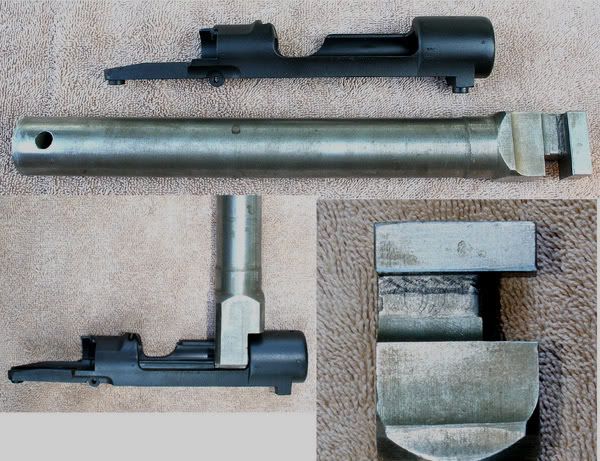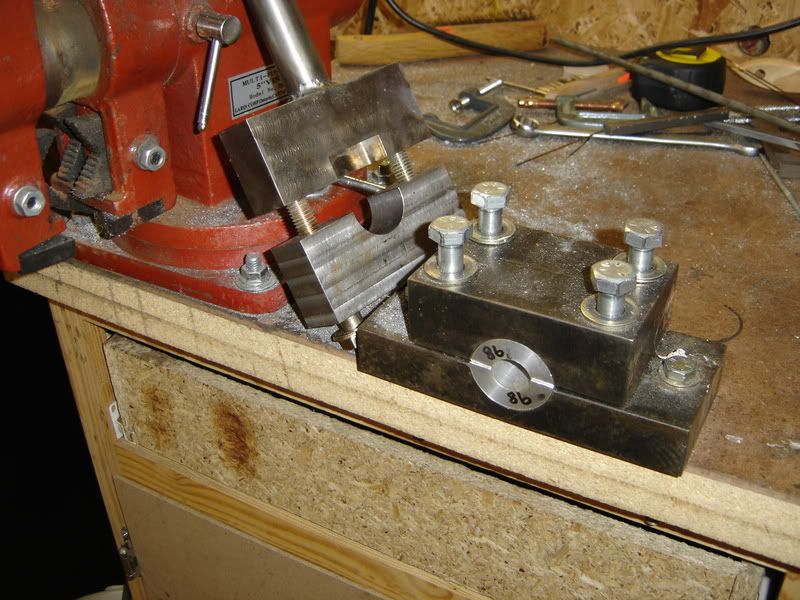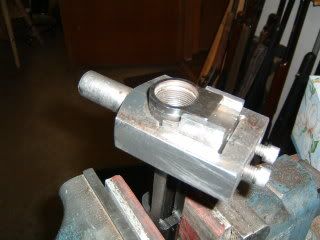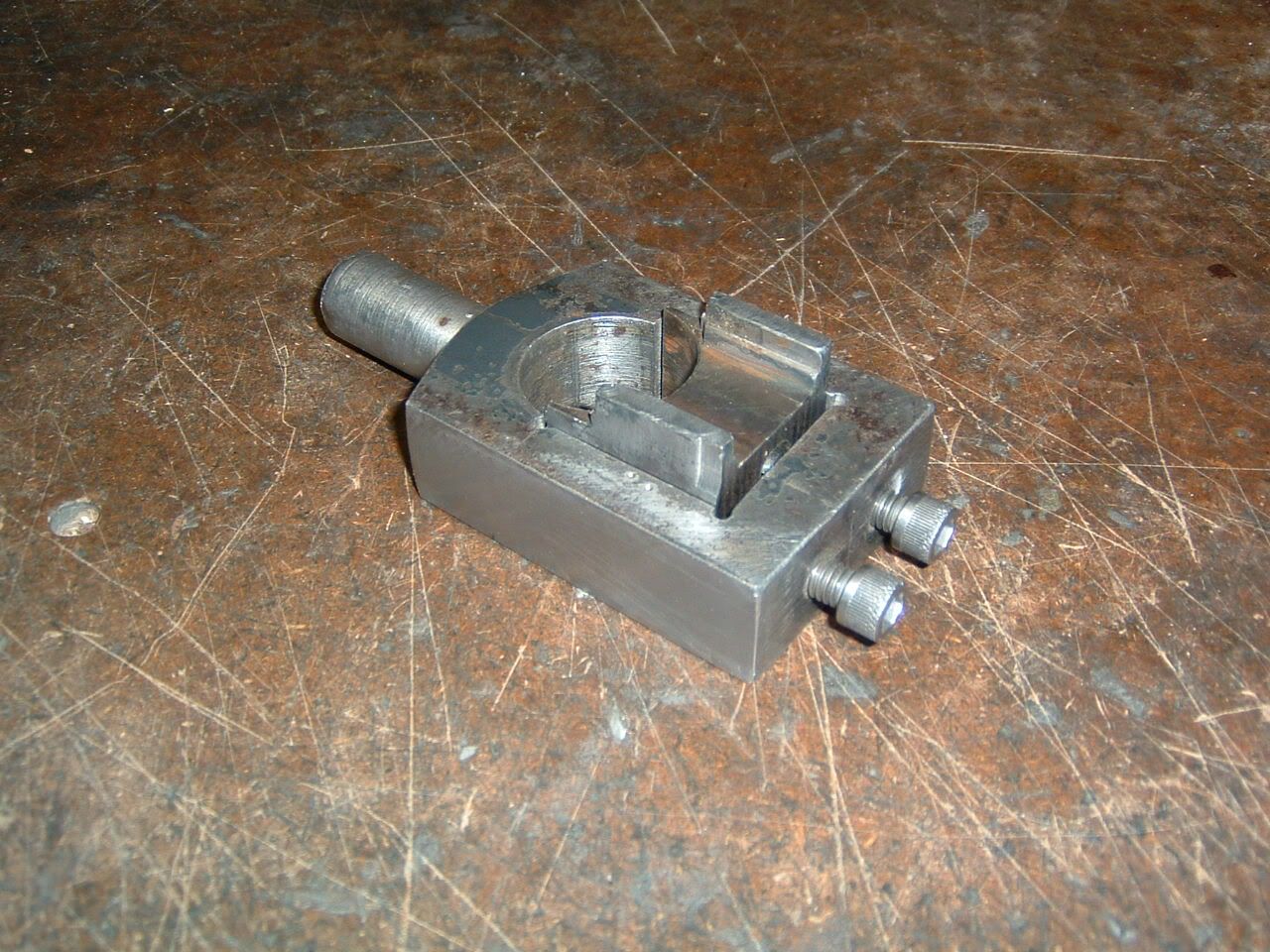

 The Accurate Reloading Forums
The Accurate Reloading Forums  THE ACCURATE RELOADING.COM FORUMS
THE ACCURATE RELOADING.COM FORUMS  Guns, Politics, Gunsmithing & Reloading
Guns, Politics, Gunsmithing & Reloading  Gunsmithing
Gunsmithing  Mauser Action Wrench Question
Mauser Action Wrench QuestionGo  | New  | Find  | Notify  | Tools  | Reply  |  |
| one of us |
Ok Fellas, Am milling the pieces for an action wrench like the Brownell's unit. What kind of fit should the depression in the handle side of the wrench have to the recoil lug? Is the depression there just to clear the lug or does its bottom face provide contact with the bottom of the lug? Thanks! Mike -------------- DRSS, Womper's Club, NRA Life Member/Charter Member NRA Golden Eagles ... Knifemaker, http://www.mstarling.com | ||
|
| one of us |
Here's the one that I made. Works quite well. I let its weight do the work not my strength.   Doug Humbarger NRA Life member Tonkin Gulf Yacht Club 72'73. Yankee Station Try to look unimportant. Your enemy might be low on ammo. | |||
|
| One of Us |
Me...I really don't like the idea on this wrench. As you try to loosen, you're straining the thinnest part of the ring. I sometimes have to use a 3 foot extension to break a 98 loose...My wrench grips the outside | |||
|
| One of Us |
if you plan to never use the barrel again put it in the lathe and use a parting tool to relieve the shoulder then unscrew it with a pipe wrench. As for the action wrench Just be sure that the radius that clears the ring is just a bit larger like .010" any smaller and it will distort the action. any larger and it will not spread out the load and will distort the action. My action wrench is a copy of the brownells unit and the bottom of the lug does not contact the wrench, but the clearance is minimal on the sides and bottom. www.KLStottlemyer.com Deport the Homeless and Give the Illegals citizenship. AT LEAST THE ILLEGALS WILL WORK | |||
|
| one of us |
I really don't care for outside wrenches as you tighten the wrench on the receiver you are also tightening the receiver on the threads. Why make things harder? This wrench reaches deep into the receiver.  Doug Humbarger NRA Life member Tonkin Gulf Yacht Club 72'73. Yankee Station Try to look unimportant. Your enemy might be low on ammo. | |||
|
| One of Us |
You don't need to tighten the wrench tight enought to compress the receiver, just snug. I made mine with lots of clearance around the recoil lug, that way I can use the bottom half for different actions. -Don  | |||
|
| one of us |
Don, Thank you again! Sometimes a challenge to make something you've never seen or used Mike -------------- DRSS, Womper's Club, NRA Life Member/Charter Member NRA Golden Eagles ... Knifemaker, http://www.mstarling.com | |||
|
one of us |
I like both styles. I use the outside wrench for disassembly of military rifles and the inside wrench for assembly with a new barrel. I don't like to assemble with a lot of force with a custom barrel. They assemble better due to the truing up machining on the action. I tighten the barrel snug enough that it will take an action wrench to disassemble...no tighter. Many ways to skin a cat though. Roger Kehr Kehr Engraving Company (360)456-0831 | |||
|
| One of Us |
It's amazing what you can do when you don't know any better. For years I used two oak blocks made from an oak 2x4 with vee groves in them. Apply rosin and put around a barrel and put in the biggest sturdy vice you can find. Then use a BIG crescent wrench on the flat behind the recoil lug and rap a couple of times with a large lead hammer. Always worked like a champ and rarely took over a couple of blows. Then I saw an action wrench and built one. Didn't actually work any better but just used it thereafter. I have only worked on Mausers,Springfield and Enfields and no other actions so only have experience with those. Ignorance is bliss so they say. I have never removed a new barrel or a factory installed barrel other than military so my experience is limited to those actions. SCI Life Member NRA Patron Life Member DRSS | |||
|
| One of Us |
Many years ago I bought a commercial example of the inside-the-rails wrench. Had to throw it in the reusable-scrap pile after 2-3 uses. Now I use a one-piece outside tool, a wide solid plate with a hole cut into it that's the same size as the receiver ring OD with a close-fitting cutout for the recoil lug and a couple of 2-foot cheater bars welded to the sides. Takes a different size tool for different receiver rings but the extra support provided by the recoil lug ensures absolutely no bent or distorted receiver rings, even with problem rifles like small ring Mausers. The close-fitting solid hole with no tightening action simply cannot compress the ring and the cheater bars provide enough leverage so that sharp blows are unnecessary. The 4-foot-long solid 1-piece wrench is unwieldy to store and to use but IMO it's worth it. If you can hold the barrel somehow without it turning then the receiver WILL come off, with no damage. I cut the hole with just enough clearance for 2 rounds of ductape on the ring, to prevent marring, and have had no problems in several years now. Regards, Joe __________________________ You can lead a human to logic but you can't make him think. NRA Life since 1976. God bless America! | |||
|
| One of Us |
[QUOTE]Originally posted by kcstott: if you plan to never use the barrel again put it in the lathe and use a parting tool to relieve the shoulder then unscrew it with a pipe wrench. It is amazing to me how this theory keeps popping up about relieving the barrel/action juncture. Jim Kobe 10841 Oxborough Ave So Bloomington MN 55437 952.884.6031 Professional member American Custom Gunmakers Guild | |||
|
| One of Us |
Why would you find it amusing?? It works. The mauser 98 barrel seats on two shoulders creating two places where friction is keeping you from unscrewing the barrel. If you relieve one of them then you have a lot less mating surface to fight getting the barrel off. On a lot of older action there is just no way to get the barrel off with tools at hand. Un less your barrel vise is bolted to the floor you can pull a heavy work bench up on two legs. www.KLStottlemyer.com Deport the Homeless and Give the Illegals citizenship. AT LEAST THE ILLEGALS WILL WORK | |||
|
| One of Us |
The original Mausers seated against the inside shoulder. Therefore, if you relieve the barrel/shoulder juncture, it will do you no good; it will still be tight against the inner shoulder. Westpac? Jim Kobe 10841 Oxborough Ave So Bloomington MN 55437 952.884.6031 Professional member American Custom Gunmakers Guild | |||
|
| One of Us |
I find myself in the rare predicament of agreeing with Mr Kobe. He is right. 1917 Enfields can certainly benefit from a relief cut, especially those Eddystones. But a Mauser is seated prmarily on the inner ring. Occassionally you get one where it butts up against the receiver face but that is more the exception than the rule. | |||
|
| One of Us |
MacFarland's book is so old, he used ink drawings. I don't make 'em like that any more. I built a number of action wrenches from lengths of 2"x2" steel per the drawing in the MacFarlnd gunsmithing book, until I realized that there must be material supporting on the bottom and the top in the same plane as the wrench bolts. Otherwise, it works, but the wrench bolts get a side bind and the action may get a scuff. The solution is to relieve the wrench face so the action can sit axially deeper into the wrench until there is large ring material on top in the same plane as the actions bolts. I did not figure that out with intelligence. I think I made one from 1.5" round stock that also had to fit an M70. I cut reliefs for the recoil lug. It worked so much better, I wondered why. The action wrench needs to be strong, but light enough to have less mass than the hammer that is to move it. When I made the wrenches from 2"x2" steel, they weighed 14 pounds, no sledge hammer I have is heavy enough to move it. I have to hit it with 2.75" diameter 9.75" length of steel that weighs 16 pounds. Swing a 16 pound dumb bell like a hammer for a minute, and you will get the idea. The newer 1.5" diameter foot long with 4" top are 8 pounds. I couple the steel section to the wood handle section with a water pipe 1.5" diameter galvanized couplings or sometimes just pieces of 1.5" galvanized water pipe. For a handle I use 2"x2" ironwood decking wood. So if I sit on the 5' handle with my 200 pounds [1000 foot pounds of torque], put Kroil in the barrel-receiver joint, and hit the wrench with a 20 pound mass [while still sitting on the handle], the 70 years of rust will crack, and the barrel comes off without a relief cut. Everyone that watches me do this goes out and buys Kroil. To get a barrel vise to handle 1000 ft pounds of torque + hammer impact [without slipping], I make Aluminum 2" long bushings from 1.5" round stock and tighten with a 3' long wrench. I make a single slit for large barrels and a double slit [two piece] bushing for small barrels. I clean all the oil off the barrel in the area to be gripped with Kleenex and alcohol. ~600 foot pounds stress on hardened 1/2-13 rod will not break it, so I pull as hard as I can on the 3' wrench in a jerking motion, using my whole body. If any Aluminum scuffs onto the barrel, it can be removed with more alcohol. The barrel vise is mounted to a 400 pound steel bench. Back when I was using Oak and rosin from Brownells, I had to make relief cuts on some old stuck surplus rifles. I have not had to do that for the last 50 times I broke 70 year old rust, since I made my new system. I have built everything with 1/2-13, even to attach the barrel vise to the 5/8" steel plate bench. But if I were starting all over, I would use 7/8-14. You may already have the threaded rod, the nuts, and the tap for making reloading dies and presses.  Play with one of these Newton toys until you understand the relationship between action wrench mass and hammer mass. | |||
|
| One of Us |
FWIW, I've removed many hundreds of barrels and never seen any 1898 that was as difficult to remove as some 1891s, 1895s and 1917 Enfields. AAMOF it has never occured to me to build a 1-piece wrench for an 1898 since my conventional B-Square setup with aluminum bushings and a Brownell's wrench has done the job OK so far. Maybe I've been lucky, but I usually have far more difficulty with small-ring early Mausers than 1898s, that's why I made the 1-piece design with 2 long cheater bars. Too easy to bend and warp things when whupping on them with a big hammer, especially with a small, thin and unhardened receiver ring such as the early Mausers. Regards, Joe __________________________ You can lead a human to logic but you can't make him think. NRA Life since 1976. God bless America! | |||
|
| one of us |
I saw your thesis on the action wrench JD and it reminded me of a wrench I got from Brownells 25 years ago! I think it was a Cherry Creek something or other. Went into the action and lined up on the lug raceway. First [1ST!] time I used it it twisted. I finally got the @#$%^%&^ thing out and straightened. Then hardened the H$$L out of it. It works NOW! It is not as strong as my others but will do the job on most actions. Aloha, Mark When the fear of death is no longer a concern----the Rules of War change!! | |||
|
| One of Us |
 The cut out on the flat bar is clearanced all round the lug. The Diameter of the half moon is 1.47 to fit a large ring mauser directlly. I make aluminum bushings for that half from 1.5 inch aluminum heavy wall tubing, and from 1.375" solid stock for the barrel wrench to fit any action, any barrel. I have some other peices to this set too that make it VERY universal. The threads are 1/2-13 so I can use my fixture mounting studs and nuts. The steel is all farm equipent salvage from my freinds metal pile. The square bar cut out for the lug was a harrow disk axel and the rest of the parts where made from a big drawbar. Rusty's Action Works Montross VA. Action work for Cowboy Shooters & Manufacturer of Stylized Rigby rifle sights. http://i61.photobucket.com/alb.../th_isofrontleft.jpg | |||
|
| One of Us |
this is the one I made about 20 years ago. It is made from a piece of 1"x2 1/2" flat bar. I use a piece of 1/2" flat stock under the screws and on the action flat. It works for the model 70 and the mausers. This one is for the model 700 and has been modified to hold the recoil lug in place. I got the wrong picture here but the one for the mauser is essentially the same   Jim Kobe 10841 Oxborough Ave So Bloomington MN 55437 952.884.6031 Professional member American Custom Gunmakers Guild | |||
|
| One of Us |
It was the only way I could get the barrel off my Eddystone. Came off like butter off a hot knife. It works without frustration. Olcrip, Nuclear Grade UBC Ret. NRA Life Member, December 2009 Politicians should wear Nascar Driver's jump suites so we can tell who their corporate sponsers are! | |||
|
| one of us |
But an Enfield ain't a Mauser.  Aut vincere aut mori | |||
|
| Moderator |
You are so right, Mike.. The reason relieving an enfield works is that it's torqued against the face of the receiver... opinions vary band of bubbas and STC hunting Club Information on Ammoguide about the416AR, 458AR, 470AR, 500AR What is an AR round? Case Drawings 416-458-470AR and 500AR. 476AR, http://www.weaponsmith.com | |||
|
one of us |
Have others found this to be true? I have never seen a Mauser, military or commercial, that bears against the face of the receiver. I thought this was left to custom and high-grade guns. Jason "You're not hard-core, unless you live hard-core." _______________________ Hunting in Africa is an adventure. The number of variables involved preclude the possibility of a perfect hunt. Some problems will arise. How you decide to handle them will determine how much you enjoy your hunt. Just tell yourself, "it's all part of the adventure." Remember, if Robert Ruark had gotten upset every time problems with Harry Selby's flat bed truck delayed the safari, Horn of the Hunter would have read like an indictment of Selby. But Ruark rolled with the punches, poured some gin, and enjoyed the adventure. -Jason Brown | |||
|
| Moderator |
military mausers seat on the C/H ring, otherwise known as a diagram.. only some custom guns try to sit on the face of the receiver 50,000,000,000 military mausers, and that's hard to be all wrong opinions vary band of bubbas and STC hunting Club Information on Ammoguide about the416AR, 458AR, 470AR, 500AR What is an AR round? Case Drawings 416-458-470AR and 500AR. 476AR, http://www.weaponsmith.com | |||
|
| one of us |
I've taken apart hundreds of milsurp mausers and the vast majority are seated in some fashion against the face of the receiver. Yes, they are designed to be seated against the inner torgue ring but most also seat against the receiver face. Pretty easy to verify by measuring shank length and comparing that to the distance from receiver face to inner "C" ring. The only Mauser I've seen that didn't at least appear to seat against the face was an interarms Mk X marked PO Ackley Inc. The shank on that one was .004" longer and when cinched up still had a gap of .002". So, cutting a relief in front of the receiver ring may loosen the load ever so slightly but since the vast majority of the load is applied to the inner "C" ring...well, you can see where I'm going.  Aut vincere aut mori | |||
|
| One of Us |
I have struggled with the function of the inner C ring for years. The Russians stopped making inner C rings in the 91/30 when they were half way through WWII and never put them back after the war. The Rem700 does not have one. I had been re barreling M98s with shoulder engagement on the large ring at the same timing as inner C shoulder engagement with the breech. Then I read on this forum 5 or 6 years ago that the old Mausers engauged the inner C ring .004" early. A first I thought that Mauser had intended the inner C to be the main mount and the large ring acts as the damper for less vibration and then more accuracy. That ad hoc analysis did not last long. I finally realized that the shoulder and large ring [when trued] have so much area that is backed up with axial direction steel, the the compliance of that fit is low. The large ring and barrel shoulder strain nearly nothing when compressed, and if the barrel turns, it is just thread crush. The inner C ring, OTOH, is smaller and slightly cantilevered. It DOES have .004" of compliance. When it is cantilever deflected, it acts as a lock washer. When the large ring gets rusted, it has more area and is further from the fulcrum for more leverage, compared to the inner C ring. Even if it was not compressed, It could use cutting if rusted. Rust grows across gaps. I took a greased up 1903 Turk apart yesterday that looked like it had never been issued since getting an 8mm barrel in 1938. It did not need 1000 foot pounds of torque + Kroil + a 20 pound sledge hammer. It only needed 40 foot pounds to take it apart. No rust, no increase in torque. | |||
|
| One of Us |
No Paul mauser designed it to seat on both shoulders not just the internal one. You know the Germans every thing to the Nth degree www.KLStottlemyer.com Deport the Homeless and Give the Illegals citizenship. AT LEAST THE ILLEGALS WILL WORK | |||
|
| One of Us |
Top barrel is Mauser military large ring thread. Not much shoulder. Bottom barrels are small ring threads.  | |||
|
| Moderator |
Got a reference for that gem of wisdom? By that, I mean a published book on MILITARY rifles. opinions vary band of bubbas and STC hunting Club Information on Ammoguide about the416AR, 458AR, 470AR, 500AR What is an AR round? Case Drawings 416-458-470AR and 500AR. 476AR, http://www.weaponsmith.com | |||
|
| One of Us |
I was taught when you rebarrel a large ring mauser to have a .002" (Crush fit / if you want to call it that) on the inner ring. This still brings the outside barrel shoulder square and flush with the reciever. Therefore I wouldnt think there would be much pressure on the front reciever face, unless it was over tightened. I have never seen a gap on a military barrel at the face of the reciever, even for a military rifle that would look like s#!t! Right or Wrong I've set em up for years this way and never had any problems...So, I'm agreeing with pressure is in the inner ring. _____________________ Steve Traxson | |||
|
One of Us |
I can only recall about two military 98's that I couldn't budge the barrels on without collapsing the front ring. With these, I relieved the barrel at the face of the receiver and they came off without a problem. I have seen 98's bearing only on the "C" ring and some bearing on both surfaces. Too me it doesn't matter which surface they are bearing on because I have developed a plan for removing both. When I rebarrel Mausers today, I seat the barrel to the face of the receiver. Just like Remington intended! mstarling, for Mausers, my wrench does not touch the lug. Only the flat and top of the front ring. If I had an inside wrench like the neat one Doug pictured above, (hint) I would use it for installing barrels. I don't like to over torque actions so an inside wrench such as that pictured above, would be just dandy! _______________________________________________________________________________ This is my rifle, there are many like it but this one is mine. My rifle is my best friend, it is my life. | |||
|
| Powered by Social Strata |
| Please Wait. Your request is being processed... |
|
 The Accurate Reloading Forums
The Accurate Reloading Forums  THE ACCURATE RELOADING.COM FORUMS
THE ACCURATE RELOADING.COM FORUMS  Guns, Politics, Gunsmithing & Reloading
Guns, Politics, Gunsmithing & Reloading  Gunsmithing
Gunsmithing  Mauser Action Wrench Question
Mauser Action Wrench Question

Visit our on-line store for AR Memorabilia

